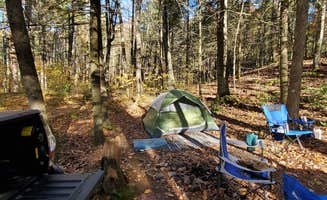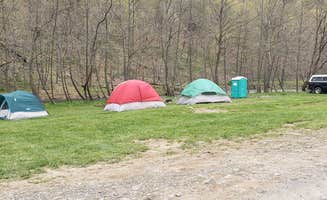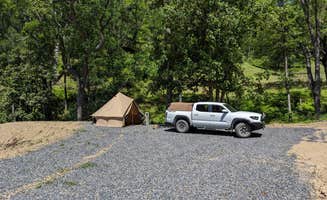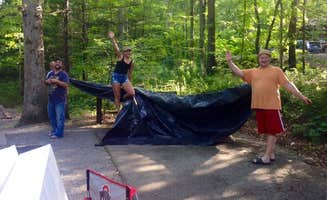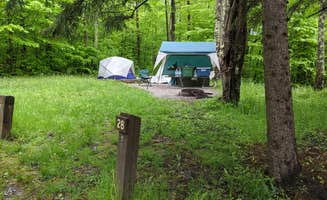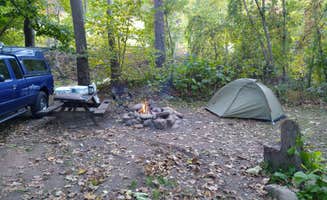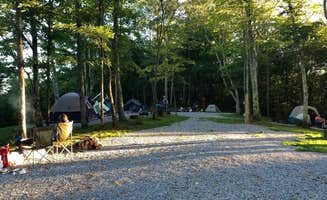Camping sites near Brandywine, West Virginia range from established facilities with amenities to remote dispersed locations requiring more preparation. The area sits at elevations between 1,000 and 4,800 feet, creating significant temperature variations. Nights remain cool even in summer months, with temperatures often dropping into the 30s during spring and fall at higher elevation campgrounds.
What to do
Fishing at multiple skill levels: Brandywine Lake Campground offers accessible fishing with a dedicated dock and stocked waters. "The lake has a small but clean beach. There is no phone service. Cellphones will not work. You need to drive 10 minutes to local stores to call for help," notes Chris J.
Tubing around Big Bend: The unique geography at Big Bend Campground creates a natural lazy river experience. "A natural lazy river surrounds the campground and is a great location for fishing and river activities. The water level was a little low, but you could still float on your inter tube around the entire loop. The entire loop took a little over an hour to complete, then a 2 minute walk, and start again," shares Jon C.
Stargazing without light pollution: The remote locations provide exceptional night sky viewing. "The highlight of my stay here were the hundreds of fireflies around my campsite in the evening...sure, I've seen lots of fireflies in my time, but never so many, it was pretty cool," reports a visitor to Big Bend Campground.
Hike from your site: Several campgrounds offer direct trail access. "This campground is a great place to stay for a weekend full of hiking. There are a number of trails that leave from the campground giving you lots of options for hikes," explains Brittany B. about Hone Quarry.
What campers like
Privacy between sites: Many campgrounds feature natural buffers. "The campground offers incredible views of nearby Seneca Rocks. While the crags are a short drive away for the lazy climbers, it's also possible to lengthen the approach and warm up the legs with a quick jaunt," shares Eric K. about Seneca Shadows.
Clean, well-maintained facilities: The quality of bathrooms ranks high in reviews. "The campground is very clean, with plenty of trash bins and protected drinking water spigots— almost every site has one nearby. The bathrooms were spotless, and the showers were hot— almost too hot! Definitely one of the best free showers we've had," reports Denis P. about Brandywine Lake Campground.
Creek-side camping options: Many campers value water proximity. "Each site is secluded and creek front. We stayed at the last site with the cliff over hang and it was magical. Several spots along the creek are deep enough for swimming," notes Sandra B. about Gandy Creek Dispersed Camping.
Diverse site configurations: From open meadows to heavily forested areas. "The A& B Loops are for tents or RVs with no electric service. The C-Loop has electricity. There's also a group camping area and a 'tent-only' camping area with walk-in sites from a nearby parking lot," explains Jennifer B. about Seneca Shadows.
What you should know
Road conditions vary dramatically: Many campgrounds require driving on unpaved roads. "The road is a mix of gravel but also dirt so it can become muddy during rain. If you follow the road, there is a river crossing that will take you to additional camp spots. The road beyond the river can get more tricky for low clearance vehicles," advises Emil D. about Switzer Lake.
Cell service is minimal or non-existent: Plan accordingly for communication needs. "There's no cell service at the sites. Starlink users beware: 0/5— the entire campground is under heavy tree cover," notes Denis P. about Brandywine Lake Campground.
Wildlife awareness required: Bears and other wildlife are common. "There are bears here, so lock up your food in the car. We have encountered a bear at or around the campsite 3 times," warns Emil D. about dispersed camping areas.
Water levels fluctuate seasonally: Plan water activities accordingly. "If you are interested in tubing on the river, May, June & July are the best months. After that the river tends to get low," advises Chris J. about Big Bend Campground.
Tips for camping with families
Consider tent-only areas for kids: Some specialized camping areas offer better experiences for families. "The first camp sites are easy to get to are close to bathrooms and a creek if you keep going down the road the road does get pretty rough and I wouldn't recommend any cars or less the 4 wheel drives at that point," suggests Breanna M. from Hone Quarry.
Check fishing options: Many sites offer family-friendly fishing. "Amazing place with tons of very primitive spots and privacy. If you travel back to U.S. 33 and drive 9.1 miles West you will find the Brandywine General Store on your left. They have kiln dried firewood, ice, bait, and supplies you may have forgot at home," notes Mike C. about Switzer Lake Dispersed Camping.
Find swimming opportunities: Look for designated swimming areas. "I love this campground because they have showers & toilets there, a fun beach on the lake for swimming and a fishing dock as well. There's actually woods around with you hiking trails unlike a lot of campgrounds ive seen recently," shares Rachel B. about Brandywine Lake.
Look for level camping areas: Some sites are more family-friendly. "This campground is mostly level, so bike riding for kids is great, walking to the lake or shower houses is very easy for those who have trouble with hills," notes Chris J. about Brandywine Lake.



